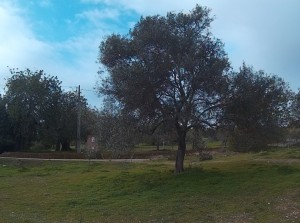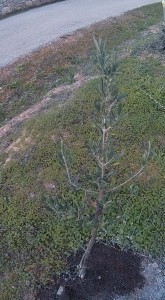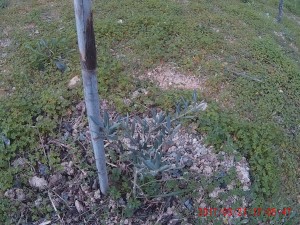2014 April , I had just been on the property for a couple of months. These early days were filled with wonder of all the trees that were on the property. The size of the property was and still is 1 hectare.
With a tiny cottage which was incomplete. No floors for one. Amongst the trees were four mature olive trees. The tallest and these was 5 m or more. In addition to these, were over 100 wild olive trees which I hardly noticed at the time except for the ones that were in heavy bloom, like in the photo below.
Quite naturally, I tended to show off the four mature olive trees to visitors then as there wasn't much else besides the wild terrain. All four of these mature olive trees were in dire need of pruning and clearance around the base area of the trees. They now are in a better state but there is definitely room for improvement.
Then I had no idea about all the different olive varieties and what was involved in producing olive oil. And today, I still haven't identified the variety of these four large mature trees. They were grafted a very long time ago. I say this , because new branches that grow off their bases give a smaller black olive (Galega?) rather than the larger green ones.
2019, five years on. I mentioned black olives earlier. A good few of the wild olives trees produced round black olives in 2019 for the first time. The olives were of a decent size. Usually wild olive trees produce tiny oval olives that haven't much weight. From this excellent guide , I think they maybe of the Galega variety.
Thus I have over the years been learning about olives and producing a little olive oil. I also conserve olives for the table but did not prepare any this year as it is a time consuming process.
As you can see, I have been planting about 40 very new olive trees on my property.
It will be some years before they produce anything but I have the patience. I am not sure what varieties they are. The guy with whom I did this joint venture said that they were Cobrançosa and Picual. I am doubtful about the ones purporting to be Cobrançosa as the leaves are short and wide rather than long and slim. From this very excellent Portuguese guide, I think they may be Arbequina. This variety is also popular is Spain where the cuttings came from. The Extra Virgin olive oil of the Arbequina is sauve and of excellent quality. So we will see. For table olives I have a four young Maçanilha and the green olives from the four mature trees are well suited to preserving in bottles.
I would love to have a micro olive oil press to experiment with all the different varieties. I don't have this option at the cooperative press I use. Out of necessity we(my neighbours and I), have to mix all varieties together to exceed the minimum half tonne required per pressing.
Properties of olive oil.
Percentage Free oleic acid.
This is what gives an oil have it greasy property. The percentage of free olive oil is also represented as a degree between 0 to 1.
The The percentage of free oleic acid of Extra Virgin olive oil must be less than 80% or 0.8 degrees. The oxidation process of olive oil will increase as the oil is exposed to air and sunlight.
This is why it is important to store olive oil in a cool dark place and in air tight containers.
Standard olive oil has almost no taste or fragrance as it almost 100% free oleic acid and is like any other vegetable cooking oil.
One of the principal health benefits of Extra Virgin olive lies in the fact that it is rich in antioxidants.
Sources:
https://www.aceitedelasvaldesas.com/en/faq/preguntas-aceite-de-oliva/acidez-del-aceite-de-oliva/
 English
English  Portuguese
Portuguese 






